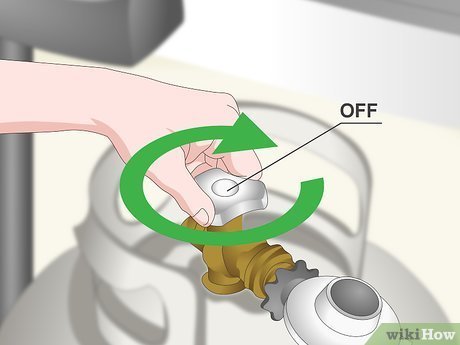Looking for a quick and easy way to turn off your gas grill? Well, you’re in luck! In this article, we will guide you through the simple steps of how to turn off your gas grill with ease. So whether you’re a seasoned grill master or a beginner just starting out, this guide is here to help you keep safety first and ensure that you can confidently turn off your gas grill whenever necessary. Let’s dive right in and learn how to turn off a gas grill effectively.
How to Turn Off a Gas Grill
Gas grills are a popular choice for outdoor cooking, offering convenience and efficiency. However, it is crucial to know how to properly turn off a gas grill to ensure safety and prevent any potential accidents. In this comprehensive guide, we will walk you through the steps to safely and effectively turn off your gas grill.
Why is it important to properly turn off a gas grill?
Before we dive into the actual process of turning off a gas grill, it’s essential to understand why this step is crucial. Failing to properly turn off your gas grill can lead to dangerous gas leaks, fire hazards, and potential damage to your grill. By following the correct procedure, you can ensure the safety of yourself, your loved ones, and your property.
Step-by-step guide to turning off a gas grill
Step 1: Close the lid
Before shutting off the gas supply, close the grill’s lid to prevent any flare-ups or potential accidents. This step helps contain any remaining heat and prevents oxygen from fueling the fire.
Step 2: Turn off the burner control knobs
Locate the burner control knobs on your gas grill. These knobs control the gas flow to the burners. Turn each knob counterclockwise, or to the “off” position. Make sure to turn off all the burner control knobs.
Step 3: Shut off the gas supply
After turning off the burner control knobs, it’s time to shut off the gas supply. Locate the gas supply valve, which is usually located near the grill’s gas tank. Turn the valve completely clockwise until it is tightly closed. This action stops the flow of gas from the propane tank to the grill.
It’s important to note that if you have a natural gas grill, the shut-off process may vary slightly. Natural gas grills typically have a shut-off valve regulated by your home’s gas supply. Consult your grill’s manual or a professional if you have a natural gas grill.
Step 4: Disconnect the gas tank
Once you have turned off the gas supply, it is safe to disconnect the propane tank from your gas grill. Unscrew the coupling nut between the gas tank and the regulator, being careful not to damage any components. Once disconnected, store the propane tank in a well-ventilated area away from heat sources.
Step 5: Clean and maintain your grill
Now that your gas grill is turned off and the gas tank is safely disconnected, it’s a good time to clean and maintain your grill. Regular cleaning and maintenance not only extend the lifespan of your grill but also ensure optimal performance. Refer to your grill’s manual for specific cleaning instructions.
Tips for safely turning off a gas grill
Safety should always be a top priority when handling gas grills. Here are some additional tips to ensure a safe experience when turning off your gas grill:
- Regularly check for gas leaks by applying a mixture of soapy water to the gas connections and watching for bubbles. If bubbles appear, there may be a leak, and you should contact a professional for assistance.
- Always follow the manufacturer’s instructions regarding the safe operation and maintenance of your specific grill model.
- Keep a fire extinguisher nearby when using a gas grill, and familiarize yourself with its proper usage.
- If you smell gas while using your grill, immediately turn off the burners, evacuate the area, and contact your local fire department or gas company.
- Store propane tanks in an upright position, away from direct sunlight and high temperatures.
Knowing how to turn off a gas grill is an essential skill for any grill enthusiast. By following the step-by-step guide outlined in this article, you can ensure the safety of yourself, your loved ones, and your property. Remember to always prioritize safety, regularly inspect your grill for any issues, and consult professionals if you encounter any problems. Happy grilling!
Turning off the grill
Frequently Asked Questions
How do I turn off a gas grill?
To turn off a gas grill, follow these steps:
Do I need to close the gas supply valve?
Yes, it is important to close the gas supply valve when turning off a gas grill. This ensures that no more gas is flowing into the grill.
Where can I find the gas supply valve on my grill?
The gas supply valve is typically located on the propane tank or natural gas line connected to your grill. It may be a lever or a knob that you need to turn clockwise to close.
What if my gas grill doesn’t have a gas supply valve?
If your gas grill doesn’t have a dedicated gas supply valve, you can turn off the gas by closing the valve on the propane tank. Simply turn the valve clockwise until it is fully closed.
Should I also turn off the burner knobs?
Yes, in addition to closing the gas supply valve, you should also turn off the burner knobs on your gas grill. This ensures that any residual gas in the system is safely released.
Is it necessary to disconnect the gas tank when turning off the grill?
It is not necessary to disconnect the gas tank from the grill every time you turn it off. However, if you won’t be using the grill for an extended period, such as during the winter, it is recommended to disconnect the gas tank and store it in a safe location.
Final Thoughts
To turn off a gas grill, follow these simple steps: first, locate the gas supply valve on the propane tank and turn it clockwise until it is fully closed. Next, turn off the grill’s control knobs by turning them clockwise until they are in the off position. Finally, ensure that the grill’s burners are completely turned off. By following these instructions, you can safely and effectively turn off your gas grill. So, next time you’re finished grilling, remember how to turn off a gas grill to ensure the safety of yourself and others.

